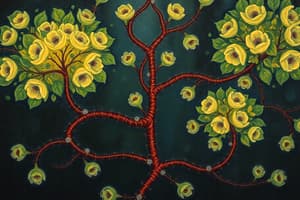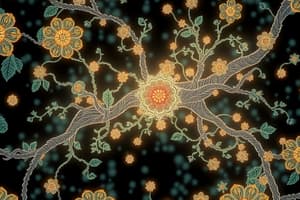Podcast
Questions and Answers
What is the primary function of acetyl-CoA in the Krebs cycle?
What is the primary function of acetyl-CoA in the Krebs cycle?
- To convert pyruvate into glucose
- To combine with oxaloacetate to form citric acid (correct)
- To generate electron carriers
- To synthesize ATP directly
During oxidative phosphorylation, how many ATP molecules are produced from one NADH molecule?
During oxidative phosphorylation, how many ATP molecules are produced from one NADH molecule?
- 2
- 1
- 3 (correct)
- 4
Which molecule is NOT a product of the Krebs cycle?
Which molecule is NOT a product of the Krebs cycle?
- FADH2
- NADH
- Acetyl-CoA (correct)
- ATP
What is the total ATP yield from one molecule of glucose after including all stages of cellular respiration?
What is the total ATP yield from one molecule of glucose after including all stages of cellular respiration?
How do fatty acids enter the Krebs cycle?
How do fatty acids enter the Krebs cycle?
What is the role of the electron transport chain during oxidative phosphorylation?
What is the role of the electron transport chain during oxidative phosphorylation?
Which statement correctly describes a characteristic of the Krebs cycle?
Which statement correctly describes a characteristic of the Krebs cycle?
In which cellular compartment does the Krebs cycle take place?
In which cellular compartment does the Krebs cycle take place?
Flashcards are hidden until you start studying
Study Notes
Krebs Cycle
- The Krebs cycle, also known as the citric acid cycle or the tricarboxylic acid (TCA) cycle, is a crucial metabolic pathway that consists of a series of chemical reactions, primarily taking place in the mitochondria of eukaryotic cells. This cycle plays a significant role in cellular respiration, which is the method by which cells convert nutrients into energy.
- This cycle follows aerobic glycolysis, which is the initial phase of glucose metabolism. During glycolysis, glucose is broken down into two molecules of pyruvate. The pyruvate, a three-carbon compound, serves as the crucial link between the glycolytic pathway and the Krebs cycle. It is through this process that the cell can efficiently utilize glucose for energy production, leading to aerobic respiration in the presence of oxygen.
- Oxygen is essential for the Krebs cycle to operate effectively, as it allows for the complete oxidation of acetyl-CoA, which is necessary for ATP generation. In the absence of oxygen, cells may rely on anaerobic pathways, which are less efficient in terms of ATP yield.
- The three-carbon pyruvate molecule generated from glycolysis undergoes decarboxylation, where it loses a carbon atom as carbon dioxide (CO2), resulting in the formation of a two-carbon molecule called acetyl-CoA. This reaction is catalyzed by the pyruvate dehydrogenase complex and includes the reduction of NAD+ to form NADH, which is an electron carrier used in subsequent energy-generating processes.
- The two-carbon acetyl-CoA molecule then enters the Krebs cycle by condensing with a four-carbon molecule known as oxaloacetate to produce citric acid (also known as citrate), a six-carbon compound. This reaction is catalyzed by the enzyme citrate synthase and represents the first step of the cycle, and citric acid is eventually converted back into oxaloacetate, thus allowing the cycle to continue.
- Throughout the Krebs cycle, there is a net loss of two carbon atoms per each acetyl-CoA that is processed, as two carbon dioxide molecules are released during two separate decarboxylation reactions. These reactions are crucial because they help to strip away carbons from the citric acid structure, ultimately leading to the recycling of the initial four-carbon oxaloacetate and enabling continued cycles of energy production.
- Significantly, each molecule of acetyl-CoA that enters the Krebs cycle results in the generation of three molecules of NADH, which is a high-energy electron carrier that plays a vital role in oxidative phosphorylation. The production of NADH is pivotal because it carries electrons to the electron transport chain, contributing to the bulk of ATP production in cellular respiration.
- Moreover, the Krebs cycle yields one molecule of FADH2 for each acetyl-CoA that is metabolized. FADH2, similar to NADH, is another electron carrier that is later utilized in the electron transport chain. The FADH2 produced is typically associated with fewer ATP molecules generated compared to those produced from NADH.
- Additionally, the Krebs cycle directly produces two ATP molecules through substrate-level phosphorylation. This process involves the direct transfer of a phosphate group to ADP, resulting in ATP formation. However, the majority of ATP generated in cellular respiration is produced downstream during oxidative phosphorylation, utilizing NADH and FADH2 as primary electron donors.
Oxidative Phosphorylation
- Oxidative phosphorylation represents the final stage of cellular respiration, which occurs following the Krebs cycle. In this critical process, the reduced coenzymes NADH and FADH2, generated from previous metabolic pathways including glycolysis and the Krebs cycle, are used to produce ATP, the primary energy currency of cells.
- The NADH and FADH2 molecules donate high-energy electrons to the electron transport chain (ETC), a complex system of proteins and enzymes embedded in the inner mitochondrial membrane. The electrons are transferred through a series of redox (reduction-oxidation) reactions across these protein complexes, facilitating the movement of protons (H+) from the mitochondrial matrix into the intermembrane space.
- As the electrons move through the electron transport chain, a significant amount of energy is released, which is harnessed to actively pump protons against their concentration gradient. This process establishes a proton gradient, or an electrochemical gradient, across the mitochondrial membrane, which is a form of stored potential energy.
- This proton gradient is then utilized by the enzyme ATP synthase, which operates through a process called chemiosmosis. The flow of protons back into the mitochondrial matrix through ATP synthase drives the phosphorylation of ADP, leading to the production of ATP. Each NADH molecule can yield approximately three molecules of ATP through oxidative phosphorylation, making it an important contributor to the overall ATP output during cellular respiration.
- In addition to the NADH produced, two molecules of FADH2 are also generated during the Krebs cycle. However, FADH2 donates its electrons at a different point in the electron transport chain, resulting in a lower ATP yield compared to NADH. Specifically, each FADH2 molecule ultimately produces about two ATP molecules.
- The total ATP yield from oxidative phosphorylation can reach approximately 30 ATP molecules, depending on the efficiency of the electron transport chain and the proton gradient established. This yield emphasizes the significance of oxidative phosphorylation as the primary means by which cells generate ATP during aerobic respiration.
- Summing up both processes, the net ATP yield for the complete metabolism of one molecule of glucose can be approximately 38 ATP. This accounting includes contributions from glycolysis, the Krebs cycle (including substrate-level phosphorylation), and oxidative phosphorylation, illustrating the efficiency of aerobic respiration as a whole.
Fat Metabolism
- Fats, also known as lipids, can be metabolized through a process called beta oxidation, which is distinct from glucose metabolism. This process takes place in the mitochondria and involves the breakdown of fatty acids into two-carbon units that eventually form acetyl-CoA, thus allowing fats to be utilized in the Krebs cycle.
- Firstly, fatty acids are activated and transported into the mitochondria, where beta oxidation occurs. In this process, successive removal of two-carbon units from the fatty acid chain occurs, producing acetyl-CoA, NADH, and FADH2 in the process. The generated acetyl-CoA can then enter the Krebs cycle, similar to how acetyl-CoA produced from glucose metabolism is processed.
- Fat metabolism is particularly efficient and generates a significantly larger amount of ATP per molecule compared to glucose. For example, the complete oxidation of a single fatty acid molecule can yield over 300 ATP entities. This remarkable ATP output is largely due to the longer carbon chains in fatty acids, which provide more acetyl-CoA units through beta oxidation, leading to an increased number of NADH and FADH2 production as well during the Krebs cycle and oxidative phosphorylation. Such energy efficiency makes fats a valuable source of long-term energy storage for the body.
Studying That Suits You
Use AI to generate personalized quizzes and flashcards to suit your learning preferences.




